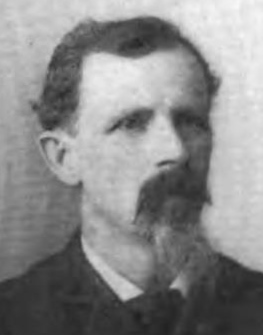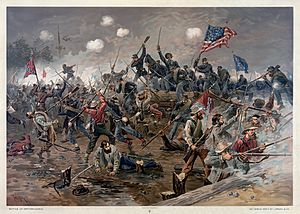Alexander H. Mitchell facts for kids
Quick facts for kids
Alexander H. Mitchell
|
|
|---|---|

Alex H. Miller, c. 1902
|
|
| Nickname(s) | Alex |
| Born | November 13, 1840 Perrysville, Pennsylvania, US |
| Died | March 7, 1913 (aged 72) Harrisburg, Pennsylvania, US |
| Allegiance | |
| Service/ |
United States Army |
| Years of service | 1861–1864 |
| Rank | Captain |
| Unit | |
| Battles/wars | American Civil War |
| Awards | Kearny Cross |
Alexander H. Mitchell (born November 13, 1840 – died March 7, 1913) was a brave American soldier. He fought for the Union Army during the American Civil War. He was a captain in the 105th Pennsylvania Infantry.
During the war, he was wounded many times. He earned the Kearny Cross for his courage at the Battle of Chancellorsville in May 1863. Later, he received the nation's highest award for bravery, the U.S. Medal of Honor. He earned this by capturing a Confederate flag in a hand-to-hand fight. This happened during the Battle of Spotsylvania Court House on May 12, 1864.
Alex Mitchell was the older brother of James George Mitchell, who later became a state senator in Pennsylvania. After the war, Alexander Mitchell worked for the state of Pennsylvania. He was a messenger for the Department of Internal Affairs from 1889 until he passed away in 1913.
Contents
Early Life and Family
Alexander H. Mitchell was born in Perrysville, Pennsylvania, on November 13, 1840. His parents were Thomas Sharp Mitchell Sr. and Sarah E. (Blose) Mitchell. His father was a merchant.
Alex grew up in Allegheny County. He went to public schools there. He had many brothers and sisters: Nancy, Andrew, Sarah Ann, Thomas Sharp Jr., Rebecca A., Martha J., James George, Malinda, Laura, and Alice R.
Friends and family called him "Alex." When the Civil War began, he was living in Jefferson County.
Fighting in the Civil War
Joining the Army
On April 18, 1861, when he was 20 years old, Alex Mitchell joined the army. He was one of the first people from Pennsylvania to volunteer. This was after President Lincoln asked for soldiers to protect Washington, D.C.. The Battle of Fort Sumter had just happened.
He joined as a private in Company K of the 8th Pennsylvania Infantry. His unit was first stationed near Chambersburg. Then they moved closer to Washington, D.C., to guard the Potomac River. In July, his unit fought in small battles near Martinsburg and Charlestown. After three months of service, he left the army honorably on July 29, 1861.
Rejoining for Three Years
Mitchell decided to join the army again, this time for three years. He re-enlisted on September 9, 1861. He became a sergeant with Company A of the 105th Pennsylvania Infantry. His younger brother, James, also joined the same company as a drummer boy.
His new unit was sent to guard Washington, D.C. They camped outside Georgetown, then moved to Alexandria, Virginia. They were part of a brigade led by Brigadier-General Charles Davis Jameson. On November 8, Mitchell was promoted to first sergeant.
First Major Battles
On March 17, 1862, Mitchell and his regiment moved to Fortress Monroe. They fought in their first big battles during the Peninsula Campaign. This included the Siege of Yorktown and the Battle of Williamsburg.
They also fought in the Battle of Fair Oaks/Seven Pines on May 31, 1862. During this battle, Mitchell was wounded.
Promotions and Awards
After fighting in the Battle of Fredericksburg in December 1862, Mitchell was promoted. He became a second lieutenant on January 15, 1863. His unit was now part of the 3rd Corps of the Army of the Potomac.
They then fought in the Chancellorsville Campaign from April 30 to May 6. After this battle, Mitchell was promoted again to first lieutenant on May 9, 1863. On May 27, he received the Kearny Badge, also known as the Kearny Cross. This award was a red diamond, a symbol of courage in the army.
Gettysburg and More Fighting
Mitchell and his regiment were part of the Gettysburg Campaign. He was wounded again during the Battle of Gettysburg. His unit, the 105th Pennsylvanians, fought bravely at Little Round Top on July 2–3.
After he recovered, he returned to his unit. Colonel Calvin A. Craig of the 105th Pennsylvania wrote about their bravery: "The One Hundred and Fifth never fought so well as at Gettysburg. We rallied some eight or ten times after the rest of the brigade had left us, and the boys fought like demons. Their battle-cry was “Pennsylvania”."
Mitchell's unit continued fighting in Virginia. They were under fire near Locust Grove in November 1863. They also took part in the Mine Run Campaign from November 27 to December 2.
Medal of Honor Action
In May 1864, Mitchell and his regiment joined Lieutenant-General Ulysses S. Grant's Overland Campaign. They immediately faced heavy fighting in the Battle of the Wilderness. On May 7, Mitchell was made a captain and put in charge of Company A.
On May 12, 1864, Mitchell showed amazing bravery. During the Battle of Spotsylvania Court House, he led his men as a first lieutenant. He was wounded while capturing the enemy's flag. He took the flag in a hand-to-hand fight with the flag-bearer of the 18th North Carolina Infantry. This act of courage earned him the U.S. Medal of Honor.
End of Service
After recovering from his wounds, Mitchell was wounded again on June 16, 1864. This happened during the Siege of Petersburg. His injuries were serious, and he was not well enough to keep fighting. He was honorably discharged from the army on November 15, 1864.
Life After the War
After leaving the military, Alexander H. Mitchell worked in the oil industry in Burning Springs, West Virginia. In 1866, he married Sarah (Repine) Mitchell.
By 1870, he was working as a well engineer. He lived with his wife and their children, Cecil and Jane/June, in Oil City, Pennsylvania. Later, they had two more children, Ross Tyson and Clara.
In 1889, his family moved to Harrisburg. Mitchell began working as a messenger for the Pennsylvania Department of Internal Affairs. He continued to live in Harrisburg with his wife and their children, Ross and Clara, until his death.
Later Years and Passing
In his later years, Mitchell suffered from heart disease. He became very ill and was confined to bed for the last year of his life.
Alexander H. Mitchell passed away at his home in Harrisburg, Pennsylvania, on March 7, 1913. He was 72 years old. He was buried at Arlington National Cemetery in Arlington, Virginia.



